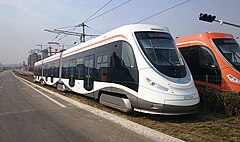History
In the 1920s, the Qingdao Municipal Government (QMG) planned to build a tramway system to replace some of the existing buses. From 1938 to 1940, Kao Electric Co., Ltd. cooperated with the QMG and set up a "tram preparation office", planning to construct the tramway system together. However, the project didn't succeed because of the lack of friction between tramway tracks and wheels due to the steep terrain in Qingdao.
In April 2013, Qingdao planned a north-south tram line with about 6 km (3.7 mi) in length, which was later changed into an east–west line in Chengyang District due to the road conditions. It was the first tramway system construction project to use the DPC (Design-Procurement-Construction) method in China. The project was completed in 2014 on 15 December. From December 17, there were events for community outreach, publicizing the vehicle signs, body colour, and station name signs. On the morning of 28 December a no-passengers test run was carried out, then continuing to test the line, vehicle, and signal system while measuring technical parameters and adjusting as necessary, driving, crew operations.
In June 2015, the project was announced by the China Transportation Enterprises Committee as "2015 annual transport enterprises low-carbon energy-saving environmental protection outstanding project." In October, the vehicle field centre machine room axis shaft equipment debugging was completed, along with the line turnout control area joint test. On 18 December, more than 40 representatives of the public were invited to try out the tram. In January 2016, it was scheduled to carry out "three-wheel" test operation review. On 5 February, the public was allowed to ride the tram as part of a free trial experience without needing a ticket. On 24 February, the third "three-wheel" expert reviewwas completed. On March 5, it began a formal passenger test operation. On 8 November, the first seven cars on the line, full line with the car were in place.
Tram route and stops
The tram route has a total length of 9 km (5.6 mi), all at-grade at ground level. The west end of the line is street running in mixed traffic (shared right-of-way), about 400 metres (1,300 ft), the rest of the line is in a semi-private right of way alongside the inside of the roadway (vehicles may cross it when making turns at intersections). There are seven hybrid substations, double insulated elastic suspension mesh, the rated voltage is 750 V DC. The stops are - Qianwangtuan station, Tianwang Road station, Shuiku Park station, Huicheng Road Station, Qingwei Road station, Guocheng Road station, Chuncheng Road station, Changcheng Road station, Agricultural University station, Mingyang Road station, Zhengyang Road station, Chengyang Wholesale Market station, a total of 12 stops, of which Agricultural University is an interchange station with Line 1 (Qingdao Metro). The route will be extended to the west to Chengyang railway station.

Hong Kong Tramways (HKT) is a 3 ft 6 in narrow-gauge tram system in Hong Kong. Owned and operated by RATP Dev, the tramway runs on Hong Kong Island between Kennedy Town and Shau Kei Wan, with a branch circulating through Happy Valley.
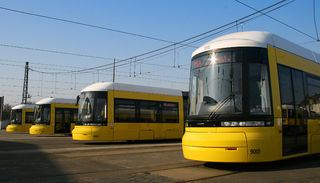
The Berlin tramway is the main tram system in Berlin, Germany. It is one of the oldest tram networks in the world having its origins in 1865 and is operated by Berliner Verkehrsbetriebe (BVG), which was founded in 1929. It is notable for being the third-largest tram system in the world, after Melbourne and St. Petersburg. Berlin's tram system is made up of 22 lines that operate across a standard gauge network, with almost 800 stops and measuring almost 190 kilometres (120 mi) in route length and 430 kilometres (270 mi) in line length. Nine of the lines, called Metrotram, operate 24 hours a day and are identified with the letter "M" before their number; the other thirteen lines are regular city tram lines and are identified by just a line number.

The Blackpool Tramway runs from Blackpool to Fleetwood on The Fylde in Lancashire, England. The line dates back to 1885 and is one of the oldest electric tramways in the world. It is operated by Blackpool Transport Services (BTS) and runs for 18 km. It carried 4.9 million passengers in 2022/23.

The Seaton Tramway is a 2 ft 9 in narrow gauge electric tramway in the East Devon district of South West England. The 3-mile (4.8 km) route runs alongside the Axe Estuary and the River Coly, running between the coastal resort of Seaton, the village of Colyford, and the ancient town of Colyton. For much of its route, it operates between the estuary and the Seaton Wetlands nature reserves, offering views of the wildlife of both.
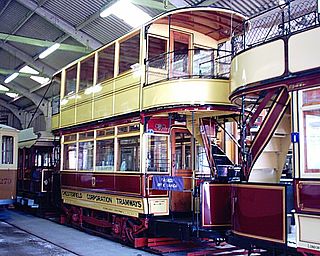
The Chesterfield and District Tramways Company and its successors ran a tramway system in the Derbyshire town of Chesterfield, England. The first horse-drawn line opened in 1882, and in 1897, the system was taken over by Chesterfield Corporation, who extended and electrified it in 1904 and 1905. Additional tramcars were purchased, but two had to be scrapped after a disastrous fire at the depot in 1916. The system suffered from a lack of maintenance as a result of reduced staffing levels during the First World War, and the trams were replaced by trolleybuses in 1927.

The Trondheim Tramway in Trondheim, Norway, is the world's most northerly tramway system, following the closure and dismantling of the Arkhangelsk tramways in Russia. It consists of one 8.8-km-long line, the Gråkallen Line, running from St. Olav's Gate in the city centre through Byåsen to Lian Station in Bymarka.

Dundee Corporation Tramways formerly served the City of Dundee in Scotland. The corporation had financed the construction of a horse tramway in 1877, but had then leased it to the Dundee and District Tramways Company. They had replaced most of the horse trams with steam tram locomotives pulling trailer cars from 1884, but in 1897 the corporation decided that it would run the tramway system itself. After some negotiation and the payment of compensation, they took over the system in 1899, with a view to electrifying it. Electric trams started running in 1900, and the changeover was completed in 1902.
Dover Corporation Tramways was the operator of the second tramway system built in the United Kingdom. It was in operation from 1897 to 1936. The worst ever tram accident in the United Kingdom occurred on the system in 1917.

The Frankfurt am Main tramway network is a network of tramways forming a major part of the public transport system in Frankfurt am Main, a city in the federal state of Hesse, Germany.

The Santa Teresa Tram, or Tramway, is a historic tram line in Rio de Janeiro, Brazil. It connects the city's centre with the primarily residential, inner-city neighbourhood of Santa Teresa, in the hills immediately southwest of downtown. It is mainly maintained as a tourist attraction and is nowadays considered a heritage tramway system, having been designated a national historic monument in 1985. The line has a very unusual gauge: 1,100 mm. The main line is 6.0 kilometres long.
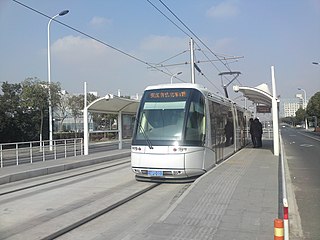
Zhangjiang Tram was a tram network operating in Shanghai that utilised a Translohr system. Shanghai originally had a steel wheeled electric tramway network in its urban center. Routes expanded gradually and reached largest extent in 1925 with 328 tramcars; this tram system shut down in 1975. Tram service returned to Shanghai with the opening of a rubber tired Translohr line in the suburban Zhangjiang Hi-Tech Park in 2010. It is the second rubber-tired tram system in both China and Asia, the first being TEDA tram in Tianjin.

Trams have been operating in Dalian continuously since 1909, making them one of the oldest tram systems still in use in mainland China. There were once eleven routes in operation in Dalian in Northeast China. Only two routes remain in use today. There was a route 203 which currently merged into route 201. Notably, most of the staff on Dalian's tram system are female, such as the driver, conductor, points man—even the depot manager. The tram system was the only rail network in the city, until Dalian Metro opened in 2003.

The Lisbon tramway network is a system of trams that serves Lisbon, the capital city of Portugal. In operation since 1873, it presently comprises six lines. The system has a length of 31 km, and 63 trams in operation. The depot is located in Santo Amaro, in Alcântara.

Torquay Tramways operated electric street trams in Torquay, Devon, England, from 1907. They were initially powered by the unusual Dolter stud-contact electrification, but in 1911 was converted to more conventional overhead-line supply. The line was extended into neighbouring Paignton in 1911 but the whole network was closed in 1934.
Llanelly and District Electric Tramways operated a standard gauge tramway service in Llanelli, Wales, between 1908 and 1933. It was the successor to a 3 ft gauge horse tramway, which ran from 1882 until 1908. A complex series of negotiations took place in the early 1900s, resulting in the horse tramway being converted to an electric tramway. Standard gauge horse trams were run initially, until the company completed North Dock power station, which supplied electricity to the tramway. Two of the employees who worked on the construction went on to found Balfour Beatty.
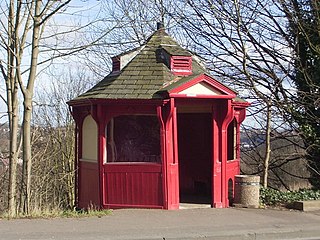
Huddersfield Corporation Tramways operated a tramway service in Huddersfield, England, between 1883 and 1940. It initially used steam locomotives pulling unpowered tramcars, but as the system was expanded, a decision was taken to change to electric traction in 1900, and the first electric trams began operating in February 1901. The system was built to the unusual gauge of 4 ft 7+3⁄4 in, in the hope that coal wagon from neighbouring coal tramways, which used that gauge, could be moved around the system. This did not occur, but two coal trams were used to delivered coal to three mills.

The Dijon tramway is a tramway system opened in Dijon, France, in September 2012. The tramway consists of two lines totaling 20 kilometres (12.4 mi) in length and serving 37 stations.

The Besançon Tram network dated back to a horse tram service inaugurated in 1887. The first two electric tram lines began operating in 1897, joined later by more. However, the system, which used only single tracks for its two lines, was badly damaged during World War II from which its finances also emerged in a parlous condition. In 1952, the operation having run out of funding possibilities, the Besançon trams were withdrawn: a city bus service was inaugurated in December 1952.

Songjiang Tram is a light rail tramway in Shanghai, China. The system consists of two lines totaling 31 km (19 mi) with 42 stations. Unlike the Zhangjiang Tram, Songjiang trams use centenary power supply and steel-wheeled rail systems. Most of them use independent rights of way. The intersection signal lights were adjusted through the system to make them pass first, and the running speed reaches 25-30km/h. Trains run from 6:00 till 22:00. With further extension of the network public transport modal split in Songjiang is expected from the current 23% to 40%.

Stockport Corporation Tramways operated a tramway service in Stockport, England, between 1901 and 1951. It was preceded by a horse tramway from Levenshulme to Stockport, which opened in 1880, and was ultimately run by the Manchester Carriage and Tramways Company. A second independent horse tramway opened in 1890, running to Hazel Grove. In 1899 the Corporation bought the first line, electrified it, and leased it back to the operating company. Their powers to buy the Stockport and Hazel Grove Tramway, authorised by the same Act of Parliament, were not exercised until 1905.

